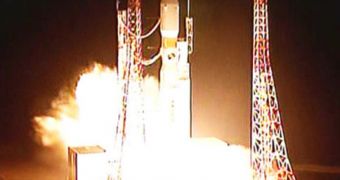In spite of concerns related to the fact that both the H-2 Transfer Vehicle (HTV-1) and the H-2B rocket were new and little tested, yesterday's launch of Japan's unmanned cargo spacecraft, destined for the International Space Station (ISS), went on without a hitch. The new craft was launched from the Tanegashima Space Center, located in southern Japan, Space reports. The take-off sequence concluded at 1:01 pm EDT (1701 GMT), the Japanese space agency JAXA reported. NASA monitored the launch from its Mission Control in Houston, as well as from other centers around the US.
“HTV-1 is opening up new horizons for JAXA's undertaking of human spaceflight. I like to say that JAXA is now entering a new era,” JAXA's Houston Office Deputy Director, Masazumi Miyake, said before the launch. The HTV-1 is now on its maiden flight in orbit, playing catch-up with the ISS. Once it arrives, it will deliver three and a half tons of supplies, ranging from food and water to science equipment and oxygen. The original design for the craft was made so that it could haul as much as six tons in a single go. The cost of the project, from the drawing board to reality, is of about $680 million.
The HTV itself costs about $220 million each, JAXA announced. With its successful deployment, Japan has entered a very select group of nations, which have the ability to deliver cargo to the $100-billion ISS via unmanned cargo ships. The Russian Federation has its Progress and Soyuz capsules, while the European Union has its Automated Transfer Vehicles (ATV). If the American space shuttles are, indeed, withdrawn in late 2010, then these spacecraft will be in charge of delivering supplies to the ISS. Astronauts will only be able to use Russian Soyuz ships to get to low-Earth orbit and back.
The new module is not designed to dock to the ISS in a conventional manner, by maneuvering itself into place. Rather, it will move close enough next to the station so that an astronaut inside, wielding the robotic arm, can grapple it and move it to its location. The system will be tested for the first time over the next days, when HTV-1 reaches the ISS. It's vitally important that it works, because future, commercial space flights may rely on the same principle of operation.

 14 DAY TRIAL //
14 DAY TRIAL //